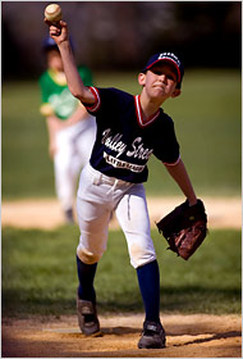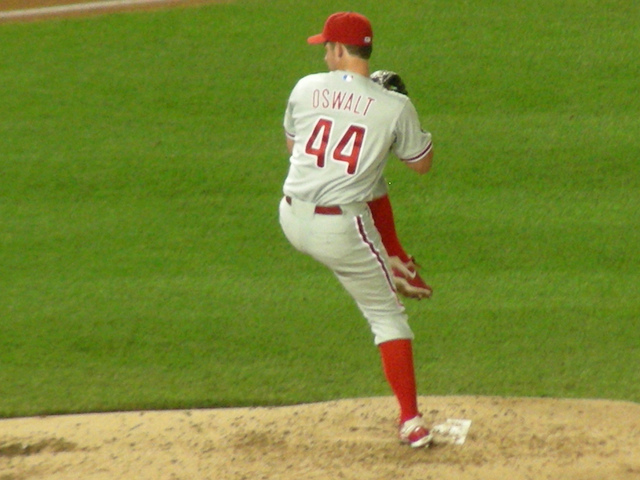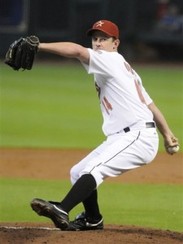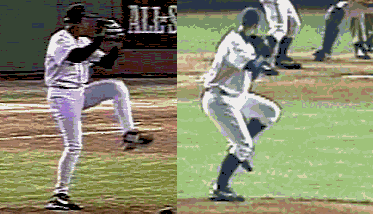|
If I were to ask you what region of the body is most important for velocity, what would your answer be? If you have been reading our articles thus far, you would probably guess the core. Sorry, guess again…. So you think you got it now? It your LEGS! More specifically your Gluteus Maximus muscles. These muscles are used to squat, walk, stand up straight, and are known as the strongest muscles in terms of weightlifting strength in the body. It is very important to always remember that pitching, and all athletic movements alike, are manifested by a kinetic link of energy that flows through the body. The force that is put on the ball at release point starts from the very tips of our toes. Then travels through the ankles, up the legs and so on. Since the legs are one of the strongest links in the kinetic chain, it would be foolish to hinder the transfer of energy during this phase. After knowing this, wouldn't it be silly not to utilize it to the Maximus?….Come on not even a chuckle? Anyways, you're in the right place to learn how to use your legs. As a player I would hear the phrases "drop and drive", "tall and fall" or "up, down, and glide out". I'm sure if you're reading this then you might have come across a coach or two who suggested such theories. Let's break down what each phrase means. Let's start with the "drop and drive" concept. What this philosophy of leg drive states is that before you make a forward movement to the plate, you need to get a deep squat with the back leg then drive down the mound. The major flaw with this movement is that you get no momentum from the leg lift. I've seen this style coached by making the player stop completely at peak leg lift, and then drop the drive leg. Since the drop happens before the drive, you are not fully utilizing all the energy generated from the leg lift. As a matter of fact, you are utilizing none of your leg drive. As I've covered in previous posts, having a stopping point at balance point is a great way to kill velocity. A premature "drop" will also lead to early pelvic tilt that is not conducive to velocity, because it will cause a front leg disconnect. Personally, I was a victim of the "tall and fall" style of leg drive, or rather lack there of. The title says it all. You are using little to no leg drive by letting your body fall down the mound with a slight lean while at peak leg lift. The pitchers that you see doing this are usually some of the slowest throwers. For example, look at some of your teammates that throw under average speed. I can almost guarantee you that they can use more of their legs in their delivery. Though they can be effective in other ways, the lack of velocity comes form the weak transfer of energy they get form their legs. Lastly there is the "up, down and glide out" approach. This is by far the weakest of the three. You are first off taking all the momentum away from the leg lift, and instead of at least driving out, you glide out. Like the tall and fall style, little leg drive is every generated. This style takes two of the worst flaws from the previous two and puts them together. The pitching coaches that teach this will tell the kids its ok to throw slow, just hit your spots. I get frustrated hearing this because it is because of the coaches lack of knowledge that they are throwing slow. Some might say that they are more accurate by doing this, but throwing low 80's forever isn't going to get you very far, that is just the truth in todays game. I also believe that you can be just as accurate using correct leg drive. Let's break down positives of these most common two philosophies: ("drop and drive" / "tall and fall"): I'm going to call it the "loaded stride". Like I said about "drop and drive", the squatting of the drive leg is a good thing, but instead of dropping first, we are going to lean first. A slight lean towards the plate takes place the moment the lift leg leaves the ground. The benefit of this is to intertwine the leg lift with the drive forward. The lean is a trait of the "tall and fall" style, but we are going to initiate the drive leg as well, shortly after. We are going to mechanically get the best of both worlds ("tall and fall" / "drop and drive"). Notice Justin Verlander's slight lean and then drive. Look at Roy Oswalt here getting a great lean towards the plate like a "tall and fall" guy would. The problem that a tall and fall guy would have is not driving with the back leg, and allowing gravity to take him down the mound. He would not use as much power, and would feel more out of control by doing this. Roy is going to try a different approach. Looking at Oswalt here, you can fill in the gaps to realize that after the initial lean, he THEN drops his drive leg into a squat position. What is also important to take note here is how his weight is on his HEEL. Getting on the toe of his foot would engage more of his quadriceps, a weaker muscle, and cause problems in the delivery due to poor timing (Side Note: Notice how Mark Prior gets to his toe sooner than Pedro Martinez on video). Roy Oswalt is around 6"0, 180 lbs and threw upwards to 97MPH in his prime. I'm tired of hearing how you need to be a physical specimen to throw 90+. Having great leg drive is just one factor that contributes to generating upper-90s velocity throughout the kinetic link.
This is where the term "loaded stride" gets its name. The energy he created with his leg lift is efficiently transferred into his leg drive. The power of his glutes is now combined with energy previously created by the leg lift lean. This delivery is now working as one, opposed to the the two parts of a "drop and drive" delivery. As a side note, despite Roy Oswalt's smaller than average size, but his legs are made of steel. Leg exercises are key to not only having the proper mechanics, but the power to back it up. Send any questions to [email protected]
0 Comments
Your comment will be posted after it is approved.
Leave a Reply. |
Core Savvy Authors : |




 RSS Feed
RSS Feed
